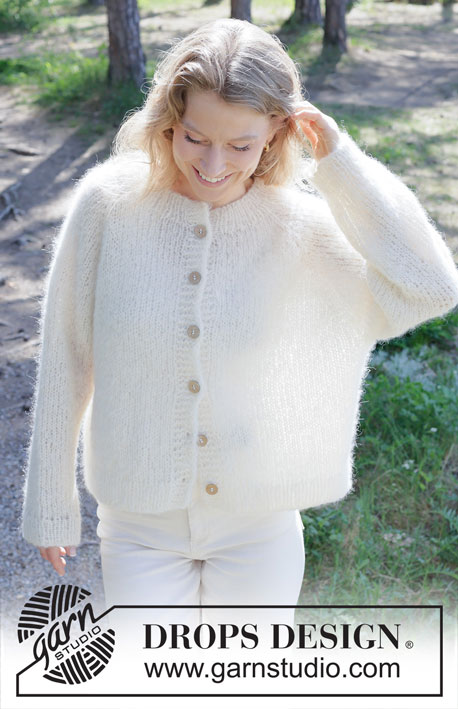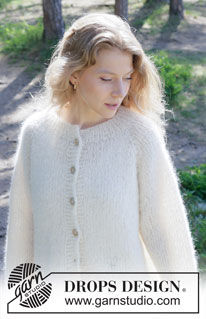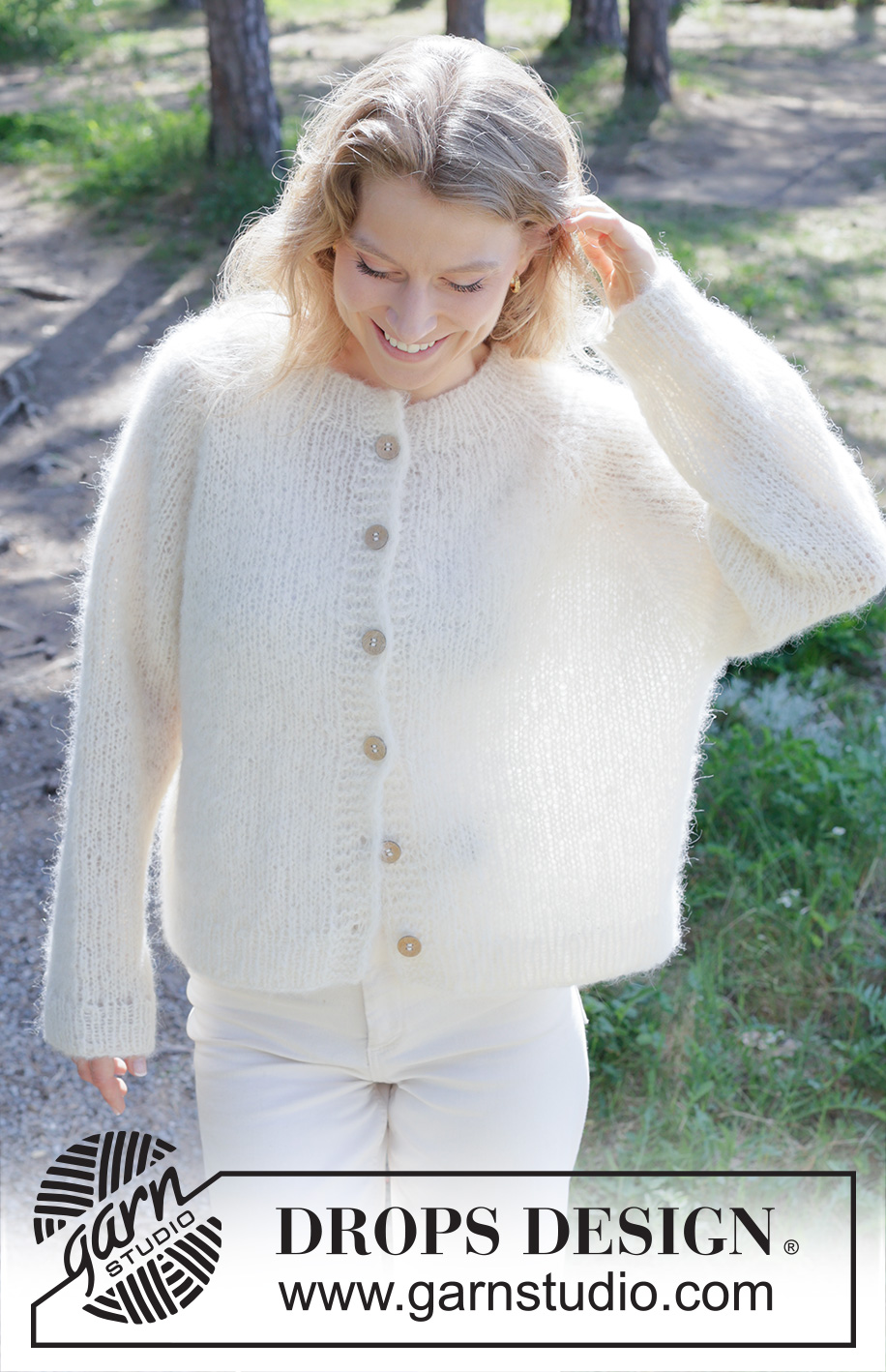Comments / Questions (18)
![]() Bettonville wrote:
Bettonville wrote:
Bonjour. Avez-vous in Tito avec film pour expliquer la bordure devant avec I-cord ?
20.03.2025 - 07:50DROPS Design answered:
Bonjour Mme Bettonville, tout à fait, retrouvez ici comment on tricote les bordures des devants au point mousse avec 2 mailles i-cord de chaque côté. Bon tricot!
20.03.2025 - 10:22
![]() Jacquelyn Duncan wrote:
Jacquelyn Duncan wrote:
I'm looking fir the sizes measured in inches for knitting with Drops Melody yarn and using this pattern. Where can I find the sizing for small, med, large , XL etc ? Thank you
18.02.2025 - 12:07
![]() Patrizia wrote:
Patrizia wrote:
Ma i ferri n.7 non erano stati indicati nella descrizione dell’occorrente!!!!
28.01.2025 - 16:12DROPS Design answered:
Buonasera Patrizia, grazie per la segnalazione, abbiamo corretto il testo. Buon lavoro!
29.01.2025 - 23:01
![]() Lorraine wrote:
Lorraine wrote:
Medium size - Divide body and sleeves: if you add 37,43,61,43,37 = 112 not 147? How many stitches should you knit? Do you knit front pieces and back piece 2x37 + 61 = 135 piece only? Or do you include 6x2 stitches under sleeve? Would make 147 just pattern says sleeves are separate does this include 6 stitches under sleeve, or 2x43 sleeves and 2x6 under sleeve after?
23.01.2025 - 15:46DROPS Design answered:
Dear Lorraine, the body section has the back piece stitches, the front piece stitches and the stitches cast on under each sleeve; the 43 stitches for each sleeve are not included and are worked separately later on. So you should have: 37 back piece stitches+ 6 cast on stitches under right sleeve + 61 front piece stitches + 6 stitches cast on under left sleeve + 37 back piece stitches = 147 stitches. Happy knitting!
25.01.2025 - 20:04
![]() Kristine wrote:
Kristine wrote:
Ang i-cordstolpen. Det står: «..strikk 1 maske rett og 4 masker i rille.». En maske rett er vel det samme som i rillen, hvordan skiller denne masken seg fra rillen iom at den er spesifikt nevnt?
19.01.2025 - 13:09DROPS Design answered:
Hei Kristine. Her er rettmasken det samme som 1 rillemaske, bortsett fra at en rillemaske har forklaring til 2 pinner, mens rettmasken har forklaring på hver pinne. Ved å forklare det slik det står, har man en bedre oversikt over at i-cord kanten består av 2 kantmasker (og hvordan de strikkes) og stolpemaskene består av 4 masker (og hvordan de strikkes). mvh DROPS Design
20.01.2025 - 13:24
![]() Oddny Stenbro wrote:
Oddny Stenbro wrote:
Skulle gjerne strikketøyet i en annen farge, hvordan kan jeg endre farge?
29.11.2024 - 16:50
![]() Lorraine Batchelder wrote:
Lorraine Batchelder wrote:
Plse can you help get me started! I have knitted the neck and having difficulty understanding the markers. Insert marker in one of the bands (mid front) is that in the middle of the 6 stitches? Also Insert marker threads without working stitches, I have 93 stitches on my needle (M size) where do you start counting stitches from as there would be 4 stitches left when you have added all the count stitches? Thanks
13.11.2024 - 15:09DROPS Design answered:
Dear Mrs Batchelder, insert this marker just after the front band stitches and leave it here, you will measure piece from here. Note that the markers for the raglan should be inserted in one stitch (and not between stitches), these 4 missing stitches might be the ones with the markers. Happy knitting!
13.11.2024 - 17:26
![]() Ineke Albers wrote:
Ineke Albers wrote:
Ik moet net voor de boord aan de onderkant vh lijf 38 steken meerderen maar dan staat er, doe dat als volgt (75, en nog heleboel andere getallen) ik brei 't vest dove feather. Kunt u mij helpen.
23.10.2024 - 15:09DROPS Design answered:
Dag Ineke,
Die reeks getallen geeft het aantal steken aan die je op de naald zou moeten hebben na het meerderen. (Het eerste getal moet trouwens 175 zijn en niet 75; dat is nu aangepast.)
24.10.2024 - 21:26
![]() Petra Ter Beek wrote:
Petra Ter Beek wrote:
Brei dit vest met verbazing, meerderen voor de boord heb ik nog niet begrepen als je van boven naar beneden breit. andersom wel na de noord meerderen
12.10.2024 - 17:22
![]() Genelot wrote:
Genelot wrote:
J aimerai trouver un modèle pareil mais avec un col en v.je ne me sens pas capable de le modifier moi même surtout en top down .Pas possible de détricoter si erreur?
10.10.2024 - 06:58DROPS Design answered:
Bonjour Mme Genelot, retrouvez ici tous nos modèles de gilets et vestes avec col V et réalisés de haut en bas, l'un d'eux fera peut-être votre bonheur - vous pouvez ajouter des filtres si besoin. Bon tricot!
10.10.2024 - 09:37
Dove Feather Cardigan#dovefeathercardigan |
|
 |
 |
Knitted jacket in 1 strand DROPS Melody or 2 strands DROPS Brushed Alpaca Silk. The piece is worked top down with raglan. Sizes S - XXXL.
DROPS 252-23 |
|
|
------------------------------------------------------- EXPLANATIONS FOR THE PATTERN: ------------------------------------------------------- GARTER STITCH (worked back and forth): Knit all rows, from both the right and wrong side. 1 ridge in height = knit 2 rows. BANDS WITH I-CORD BEGINNING OF ROW: Slip 1 stitch purl-wise with strand in front, knit 1, work 4 garter stitches. END OF ROW: Work until there are 6 stitches left on the row, work 4 garter stitches, slip 1 stitch purl-wise with strand in front, knit 1. Work in the same way from both the right and wrong side. BUTTONHOLES: Work the buttonholes on the right band (when the garment is worn) from the right side, when there are 5 stitches left on the row. ROW 1 (right side): Make 1 yarn over, knit 2 together, knit 1, slip 1 stitch purl-wise with strand in front, knit 1. ROW 2 (wrong side): Work the band as before, knitting the yarn over to leave a hole. The first buttonhole is worked on the first row from the right side after the neckline is finished. Then work the other 5-5-5-6-6-6 buttonholes with approx. 8-8½-9-7½-8-8½ cm between each one. The bottom buttonhole is worked in the transition between the stocking stitch and rib. RAGLAN: Increase 1 stitch by making 1 yarn over, which is then worked on the next row as follows: BEFORE MARKER-THREAD: Purl the yarn-over through the back loop to avoid a hole. Then work the new stitch in stocking stitch. AFTER MARKER-THREAD: Slip the yarn-over off the left needle and replace it twisted (insert the left needle through the back when replacing it). Purl the front loop of the yarn-over to avoid a hole. Then work the new stitch in stocking stitch. DECREASE TIP: Decrease 1 stitch on each side of the marker-thread as follows: Work until there are 3 stitches left before the marker-thread, knit 2 together, knit 2 (marker-thread sits between these 2 stitches), slip 1 stitch knit-wise, knit 1 and pass the slipped stitch over the knitted stitch (2 stitches decreased). ------------------------------------------------------- START THE PIECE HERE: ------------------------------------------------------- JACKET – SHORT OVERVIEW OF THE PIECE. The pattern uses both long and short needles; start with the length which fits the number of stitches and change when necessary. The neck and yoke are worked back and forth with circular needle, from mid front and top down. When the yoke is finished, it is divided for body and sleeves and the body continued back and forth with circular needle, while the sleeves wait. The sleeves are worked in the round, top down. NECK: Cast on 87-93-95-101-103-109 stitches with circular needle size 4.5 mm and 1 strand DROPS Melody or 2 strands DROPS Brushed Alpaca Silk. Work as follows from the right side: 6 stitches according to BANDS WITH I-CORD – read description above, work rib (knit 1, purl 1) until there are 7 stitches left, knit 1 and 6 stitches according to bands with I-cord. Continue this rib for 4 cm – with the last row from the wrong side. Insert 1 marker inside one of the bands (= mid-front); the piece is now measured from here. YOKE: Insert 4 marker-threads, without working the stitches, inserting them in 1 stitch (raglan-stitch) which is worked in stocking stitch. Count 18-20-20-22-22-24 stitches (= left front piece), insert 1 marker-thread in the next stitch, count 11 stitches (= sleeve), insert 1 marker-thread in the next stitch, count 25-27-29-31-33-35 stitches (= back piece), insert 1 marker-thread in the next stitch, count 11 stitches (= sleeve), insert 1 marker-thread in the next stitch. There are 18-20-20-22-22-24 stitches left after the last marker-thread (= right front piece). Change to circular needle size 7 mm. Work stocking stitch back and forth, with the bands as before - remember the BUTTONHOLES. AT THE SAME TIME increase for RAGLAN on each side of all 4 marker-threads - read description above (= 8 increased stitches), every 2nd row 15-16-17-19-20-22 times = 207-221-231-253-263-285 stitches. Remember to maintain the knitting tension. Continue with stocking stitch and bands as before without further increases until the piece measures 20-22-23-24-26-28 cm from the marker mid-front. Now divide for the body and sleeves. DIVIDE FOR BODY AND SLEEVES: On the next row work as follows: Work 34-37-38-42-44-48 stitches as before (= front piece), place the next 41-43-45-49-49-53 stitches on 1 thread for the sleeve, cast on 6-6-8-8-10-12 stitches (in side mid-under sleeve), work 57-61-65-71-77-83 stitches (= back piece), place the next 41-43-45-49-49-53 stitches on 1 thread for the sleeve, cast on 6-6-8-8-10-12 stitches (in side mid-under sleeve), work the last 34-37-38-42-44-48 stitches (= front piece). The body and sleeves are finished separately. BODY: = 137-147-157-171-185-203 stitches. Continue with stocking stitch and bands as before until the piece measures 42-44-46-48-50-52 cm from the marker mid-front. On the next row from the right side, work rib AT THE SAME TIME as you increase 38-42-46-48-54-58 stitches evenly spaced as follows (75-189-203-219-239-261 stitches): Change to circular needle size 4.5 mm. Work the band as before, work rib (knit 1, purl 1 – remember to increase) until there are 7 stitches left, knit 1 and work the band as before. When the rib measures 4 cm, cast off with knit over knit and purl over purl. The jacket measures approx. 46-48-50-52-54-56 cm from the marker and approx. 50-52-54-56-58-60 cm from top of shoulder. SLEEVES: Place the 41-43-45-49-49-53 sleeve-stitches from the thread on one side of the piece on short circular needle size 7 mm and knit up 1 stitch in each of the 6-6-8-8-10-12 stitches cast on under the sleeve = 47-49-53-57-59-65 stitches. Insert a marker-thread in the middle of the 6-6-8-8-10-12 stitches under the sleeve. Start at the marker-thread and work stocking stitch in the round. When the sleeve measures 2 cm, decrease under the sleeve – read DECREASE TIP. Decrease 2 stitches every 8-6-5-4-4-2½ cm a total of 5-6-7-9-9-12 times = 37-37-39-39-41-41 stitches. Continue working until the sleeve measures 41-39-38-37-36-34 cm from the division. Change to double pointed needles size 4.5 mm. Work rib (knit 1, purl 1), AT THE SAME TIME increase 11-11-13-13-13-13 stitches evenly on the first round = 48-48-52-52-54-54 stitches. When the rib measures 4 cm, cast off with rib. The sleeve measures approx. 45-43-42-41-40-38 cm from the division. ASSEMBLY: Sew the buttons onto the left band. |
|

|
|
Have you finished this pattern?Tag your pictures with #dropspattern #dovefeathercardigan or submit them to the #dropsfan gallery. Do you need help with this pattern?You'll find 30 tutorial videos, a Comments/Questions area and more by visiting the pattern on garnstudio.com. © 1982-2025 DROPS Design A/S. We reserve all rights. This document, including all its sub-sections, has copyrights. Read more about what you can do with our patterns at the bottom of each pattern on our site. |
|











































































Post a comment to pattern DROPS 252-23
We would love to hear what you have to say about this pattern!
If you want to leave a question, please make sure you select the correct category in the form below, to speed up the answering process. Required fields are marked *.